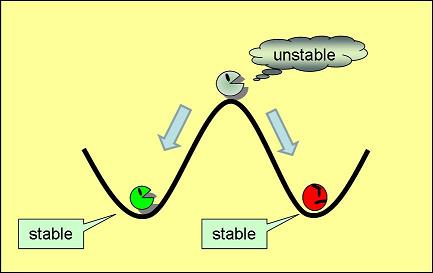Tokyo/Requirements
From 2007.igem.org
Abstract Concept & Model Requirements Genetic_circuit Works About_our_team
The most important and underlying point of our model is that the system is stable against environmental changes when two or more types of individuals coexist, called "stable coexistence." Our project have aimed at this "stable coexistence" but not dynamic equilibrium such as chemical ones.
To achieve this “stable coexistence", our model requires
1. bistability at two distinct states in a single cell
2. cell-cell communication by quarum sensing
1. Bistability
1-1. At an individual level
For "stable coexistence" in our model, two types of cells should coexist stably. Therefore, cells with THE SAME GENE SET need to take TWO STATE STATES, A (Worker) and B (Idler) in our project as shown in Fig. 1. To be clearly distinduished from dynamic stability, "stable coexistence" must be achieved by two distinct states unconvertible each other.
1-2. At a collective level
To achieve "stable coexistence", each cell needs to recognize cell types - the ratio of A and B - around itself.
As is often the case bacteria in the nature, our modified cells here sense the types of coexisting cells by cell-cell communication called quorum sensing. Under the coexistence of A and B at a specific ratio, the whole system (or group) is collectively stable. Fig. 2 simply shows this scheme.
2. Cell-cell communication
When this stable coexistence is disrupted, by removing all the A type for example, these individual cells sense the change. Their states A or B become unstable as if cells became upset - INDIVIDUAL STATES ARE UNSTABLE ⇒ They are COLLECTIVELY UNSTABLE. Then some of them changed their states while the others do not. As a result, at a certain ratio of A and B again, the whole system comes back to a stable states. Here the cells are COLLECTIVELY STABLE ⇒ INDIVIDUALS ARE STABLE under this stable coexistence.
